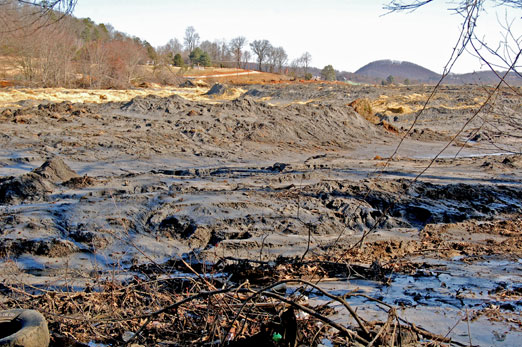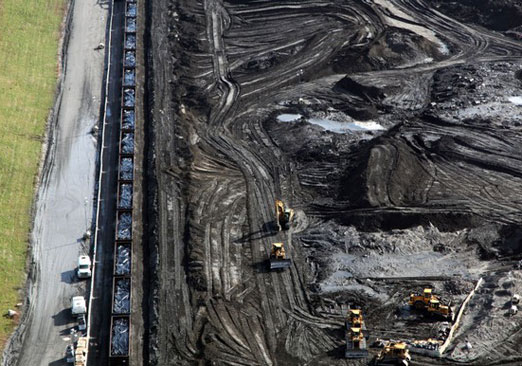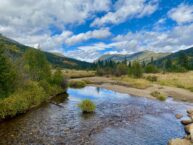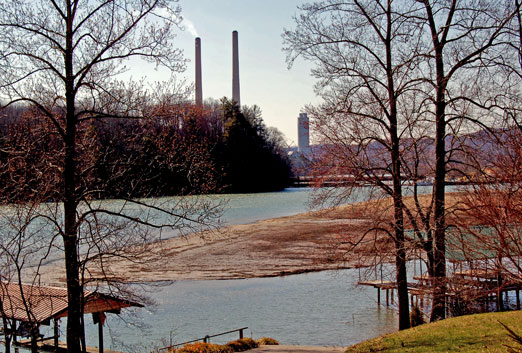
A view of the TVA coal fired power plant at Kingston Tennessee across the Emory River in 2009. That is not a natural island in the river. It is an island of toxic coal ash: Glynn Wilson
Editor’s Note: For the past five years, while the New American Journal has continued to keep up with some major stories related to the natural environment such as the latest news on global warming and climate change, our priorities have tended to focus largely on coverage of national science and public affairs, and some state politics, because of the existential threat posed by the Trump administration to democracy itself.
Now that certain segments of the American public worked altruistically together successfully to dump Trump in the 2020 election cycle, there are more qualified people moving back into leadership positions in the national government. So without having to deal with the daily Trump Tweet Storm now, we are planning to get back to one of our major focus areas — covering the environment.
As many regular readers already know, this has been a specialty of Glynn Wilson, editor and publisher, since he was one of the first full-time reporters covering the environment as a beat for newspapers back in the 1980s, who was there in New Orleans in 1990 as a charter member of the Society of Environmental Journalists. We started covering politics and the environment online full time from here in 2005, when the newspapers first started dying due to advances in web publishing and the advent of the internet.
By Glynn Wilson –
KNOXVILLE, Tenn. — Twelve years ago this March, appalled that the largest industrial spill in United States environmental history was largely being ignored or buried by the mainstream media in America, I took to the MoJo road and traveled from Birmingham, Alabama, to Knoxville, Tennessee, to see and cover the TVA coal ash spill for myself.
Related: TVA to Begin Coal Ash Spill Cleanup March 20
Video –
Maybe it was because the disaster happened right before Christmas in December, or because the nation’s attention was focused on the historic election of the first African American President, Barack Obama, in November. Or maybe it was because coal ash was not an issue that had been pushed by environmental non-profit groups before, or reported on by journalists covering the environment as a beat.
Facebook was brand new then, and most people were not on it yet. And it wasn’t exactly a story with live video for the CNN helicopter.
Whatever the reason, it was clear that what came to be known as “the second largest domestic environmental disaster in the U.S.” after the BP Oil Spill happened in the Gulf of Mexico in 2010, was just not dominating the front pages of newspapers or coverage on cable TV news. It should have exploded on the scene like the Exxon Valdez oil spill in Prince William Sound, Alaska, in the spring of 1989. Instead, the major geological disaster seemed to be a sleeper story that would take some effort to expose.
On December 22, 2008, at approximately 1 a.m., a failure of the northwest side of a dike used to contain coal ash occurred at the dewatering area of the Tennessee Valley Authority’s coal-fired power plant in Kingston, Tennessee. When the dike collapsed, overnight 1.1 billion gallons (4.2 million cubic metres) of coal fly ash slurry was released, immediately filling up and overflowing the Swan Pond embayment and dumping so much material into the Emory and Clinch Rivers where they met at Kingston that it literally dammed up the rivers temporarily, both tributaries of the Tennessee River, also impacted by the geological disaster that was more than a mere spill.
The disastrous event created a mountain of toxic sludge that covered 300 acres (1.2 km2) of the surrounding land, resulted in millions of dollars worth of property damage and rendered many properties uninhabitable, as well as causing untold damage to the local ecosystem.
TVA’s coal-fired power plants had already been criticized for turning the air in Knoxville into the second most polluted in the country next to the air in Los Angeles, California, a story I covered for the alternative weekly newspaper in Knoxville called MetroPulse back in the late 1990s (which was later killed and put out of the business by the corporate newspaper chain in Knoxville without even bothering to preserve the archives online).
Like many power plants around the region and the country, the Kingston plant used a series of ponds to store and drain the fly ash, a byproduct of coal combustion used to create power by burning the dirtiest fossil fuel of them all. The initial spill cost TVA more than $1 billion to cleanup, a process that was declared complete in 2015.
But not before creating another environmental disaster and major controversy down in Alabama’s Black Belt, where the coal ash was taken after being dug out of the rivers and transported by train and dumped into Perry County’s Arrowhead Landfill, another story we covered in great depth at the time.
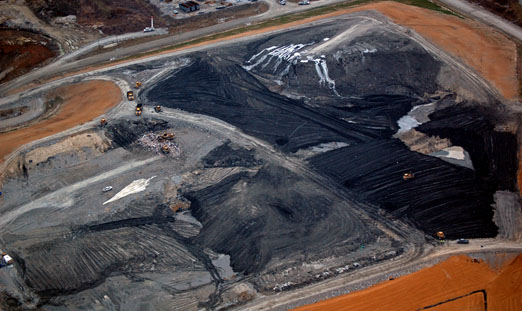
The toxic TVA coal ash mountain grows higher every day at the Arrowhead Landfill in Alabama’s Black Belt as millions of tons make their way down in train after train from one of the worst environmental disasters in U.S. history at Kingston, Tennessee: Glynn Wilson
Related: Toxic TVA Coal Ash Mountain Grows in Black Belt
TVA was found liable for the spill in August 2012 by the U.S. District Court for the Eastern District of Tennessee. While the initial spill resulted in no injuries or deaths, several of the employees of an engineering firm hired by TVA to clean up the spill developed serious illnesses, including brain cancer, lung cancer, and leukemia — as a direct result of exposure to the toxic coal ash — and by the 10 year anniversary of the spill in 2018, more than 30 had died.
In November 2018, a federal jury ruled that the contractor did not properly inform the workers about the dangers of exposure to coal ash and had failed to provide them with necessary personal protective equipment.
Related Coverage: TVA Coal Ash Spill
Going Forward
Meanwhile, the coverage of that initial coal ash disaster has led to a push to regulate the toxic substance by federal and state government agencies, and environmental groups are fighting plans by power companies in Tennessee, North Carolina, Alabama and other states to simply bury and coverup their coal ash — rather than disposing of it or using it to develop useful products.
Web searches for toxic coal ash turned up more than 10 million results now and reveal controversies in states across the country, especially Alabama, Tennessee and North Carolina, states where we have some resources and access to cover news.
Federal Regs
Back in 2017, after President Donald Trump nominated Scott Pruitt as a cabinet level official over the Environmental Protection Agency (EPA), that federal agency’s website was stripped of information about global warming and climate change, including specific related issues such as tar sands oil and coal ash. The agency’s email lists were disabled, making it hard to cover these issues.
Just this week, we have already started putting pressure on the Biden administration to get them going again, and we are now in contact with the EPA top staff and press officials to begin putting out information on these issues.
Media Coverage
The problem again is that even more newspapers have gone out of business since 2008, leaving broadcast news outlets without a foundation of print reporting on which to base their news coverage. Some of the corporate chain news outlets that still exist hide their content behind pay walls, leading to a digital divide that prevents large segments of the American public from finding out what’s really going on. Some take money from the fossil fuel industry in the form of advertising — money we refuse to accept.
A number of non-profit environmental groups are putting out information about the issue, but quite frankly they just appear to use the controversies to raise the money to pay staff salaries and administrative costs. They are hampered by their IRS non-profit status and prevented from taking on politicians like we can as independent journalists.
So we are asking that some of these environmental groups and individuals concerned about this and other environmental stories consider finding ways to help fund our work. An ad on this site for a non-profit group only costs $100 a month. We would rather raise money for sources and sponsors than to constantly ask people for money for ourselves. But the fact is, we cannot travel all around to cover all these controversies without the necessary funding.
We are uniquely qualified to do this work. For more information, you can read about our successes on the environmental front in this book.
Jump On The Bus: Make Democracy Work Again
We have an ongoing fund raiser already at GoFundMe: If you want to help fund this journalism, click on the link, read all about it, and make your contribution today.
GoFundMe: Keep the Press Alive in a COVID World
More Photos
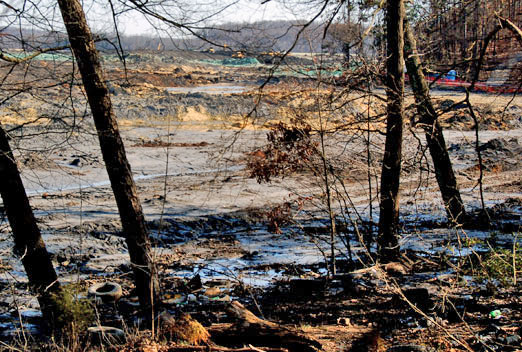
A six mile long land mass of coal ash where the most vibrant and biologically diverse stretch of the Emory River used to be: Glynn Wilson
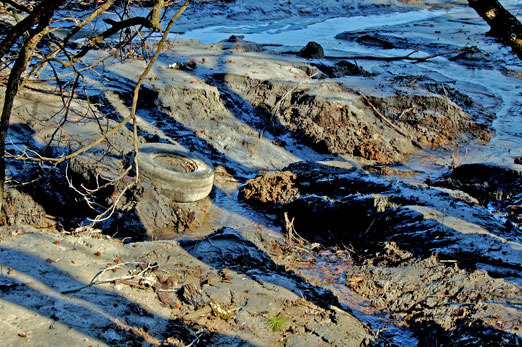
A six mile long land mass of coal ash where the most vibrant and biologically diverse stretch of the Emory River used to be: Glynn Wilson


